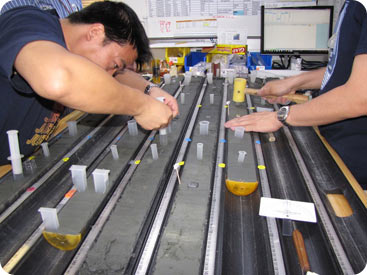If you dig into the muck at the ocean floor, you’ll find layers of ash deposited by volcanic eruptions and by the impacts of giant boulders from space. You’ll also find minerals, pollen grains, and spores that washed into the oceans from the land, and the skeletons of microscopic animals that died long ago.
 Scientists on the JOIDES Resolution working on core sediment samples. Credit:Integrated Ocean Drilling Program, William Crawford
Scientists on the JOIDES Resolution working on core sediment samples. Credit:Integrated Ocean Drilling Program, William Crawford These and much more are contained in layers of sediments. Scientists probe them by dropping a hollow tube into the sediments and pulling up layers from as far as two-thirds of a mile down.
A core is split lengthwise, with one side used for current studies and the other stored for future use. Scientists photograph the core, measure the depth of each layer, and make a rough determination of what each layer contains. They then take small samples for more detailed analysis.
One of the most important things they want to know is when each layer was deposited. They find out by studying the types of microscopic fossils the layers contain, measuring the magnetic field imprinted in each layer, and measuring the amounts of different forms of oxygen, all of which change over time.
Knowing when each layer was deposited helps reveal what conditions were like in the oceans thousands or even millions of years ago. Conditions in the oceans reflect conditions in the atmosphere, so the cores also help scientists learn how Earth’s climate has changed. That information helps them understand how the climate may change in the future -- change that will be recorded in future layers of sediments.

